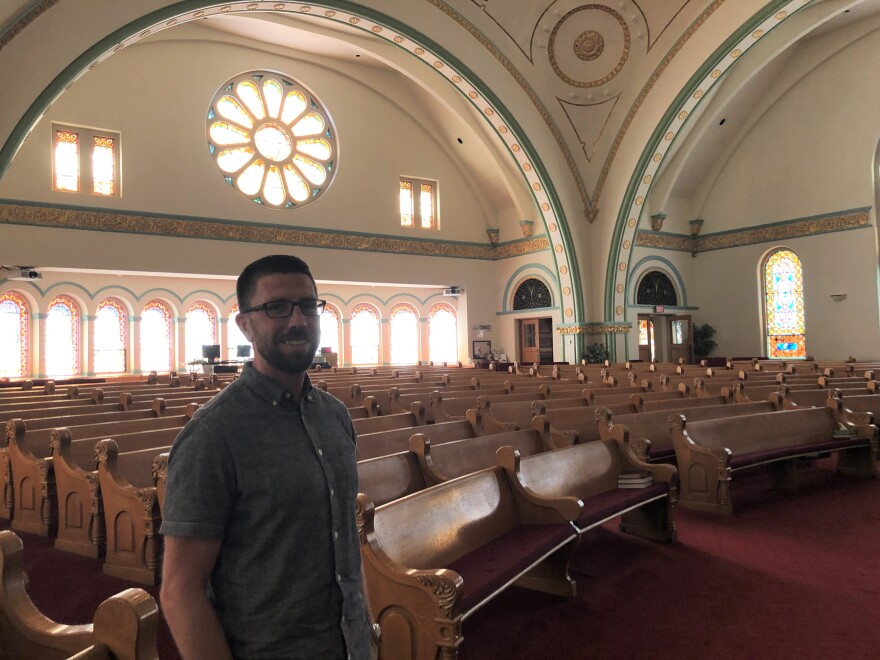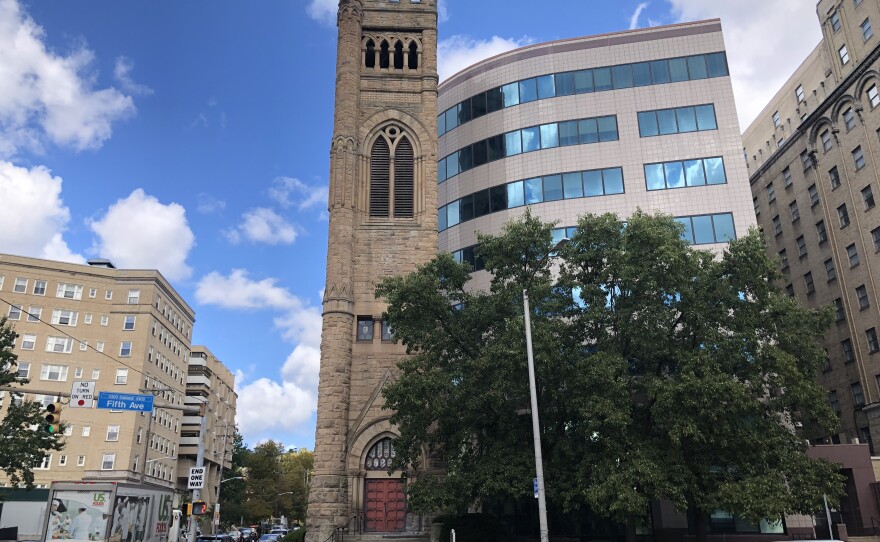A weathered stone structure sits quietly on the corner of Fifth and Bellefield avenues in Oakland as students, cars and buses hurry past. Six sandstone steps guide visitors to a big red door framed by black wrought iron fasteners.

The tower and its neighbor, a sleek office building with blue tinted windows, are an unlikely pair, which prompted Good Question! asker Graham Snyder’s inquiry.
“I usually commute down Fifth Avenue and it suddenly occurred to me that something didn’t fit right on that corner and I wondered: why is there a stone tower by itself in front of a modern building?” Snyder asked.

Bellefield Tower is the last remnant of a church and congregation that once occupied the corner. Its history begins in the 1800s, when goats roamed the farmland of Oakland. Josh Brown, pastor of Bellefield Presbyterian Church on Thackeray Avenue, said the land where the tower sits was owned by Neville B. Craig, the editor of the Pittsburgh Gazette from 1829-1841. Craig had family members named Isabel and called the farm “Bellefield.”
“Bellefield was originally its own kind of distinct neighborhood here within Oakland,” Brown said. Meanwhile, a congregation called First United Presbyterian outgrew its downtown building and moved to Oakland. The church on Thackeray Avenue, where Brown preaches, was built in 1896 and became home for the First United congregation. The property was deeded to the church by Mary Schenley, the wealthy granddaughter of businessman James O’Hara, who’s best remembered for donating land for Schenley Park.
A few blocks away, a separate Bible study group had grown large enough to warrant the construction of a church. Architect Frederick J. Osterling built Bellefield Presbyterian Church in 1889. Osterling would go on to design Downtown’s Arrott Building on Fourth Avenue and the Union Trust Building on Grant Street. He also made alterations to the iconic Allegheny County Courthouse (formerly the jail).
Sponsored by the Baum Boulevard Automotive, Eisler Landscapes, and the CPA firm Sisterson and Company.
“It was a very beautiful Gothic Revival church, sandstone, red mortar, with Romanesque detailing,” said Louise Sturgess, executive director of Pittsburgh History and Landmarks Foundation. “If you look at the capitals of the columns that are still on the tower, you can see them, you’ll see carved leaf-like elements.”
For decades, Bellefield Presbyterian and First United Presbyterian co-existed, separated by denominational differences. Then in 1967, the Pittsburgh Presbytery, the regional governing body of the churches, voted to merge the two congregations. Brown said the Thackeray Avenue location was in better condition than the Bellefield Avenue church, so the worshippers combined to the First United building.

“As kind of a tribute to the other group, they said you can bring the name Bellefield with you,” Brown said. “It was a sort of a little olive branch offering.”
This is part of our Good Question! series where we investigate what you've always wondered about Pittsburgh, its people and its culture.
Not everyone was thrilled with the merger, Brown said, but eventually people came around. The newly combined congregation no longer needed the Bellefield location. It was given to the Pittsburgh Presbytery for use by the United Oakland Ministry and eventually sold to the University of Pittsburgh. In the mid-1980s, the National Development Corp. of Pittsburgh wanted to build an office complex where Bellefield church stood.

“There was a community uproar. People protested,” Sturgess said. “And so the architects said we can save the tower.”
A March 10, 1985 Pittsburgh Press article described the situation:
“The Gothic-style tower will not be functional in that it won’t have a bell, nor will it be open to the public. It will stand by itself.”
Part of the original church wall frames a small, shaded courtyard nearby, but the rest of the building is gone. Sturgess said the tower is a reminder of the importance of preserving historic buildings “if only in part.”
*This story has been updated to reflect that Mary Schenley was James O'Hara's granddaughter, not daughter.








